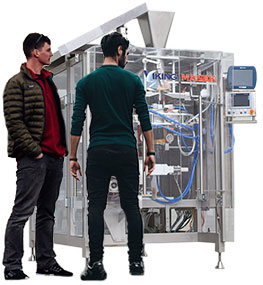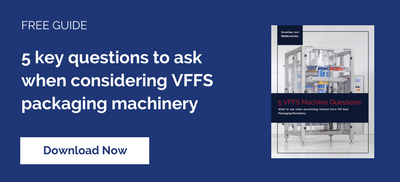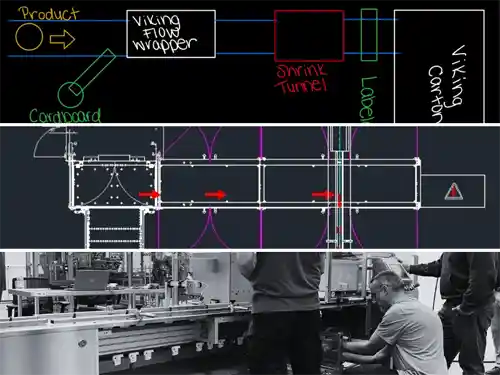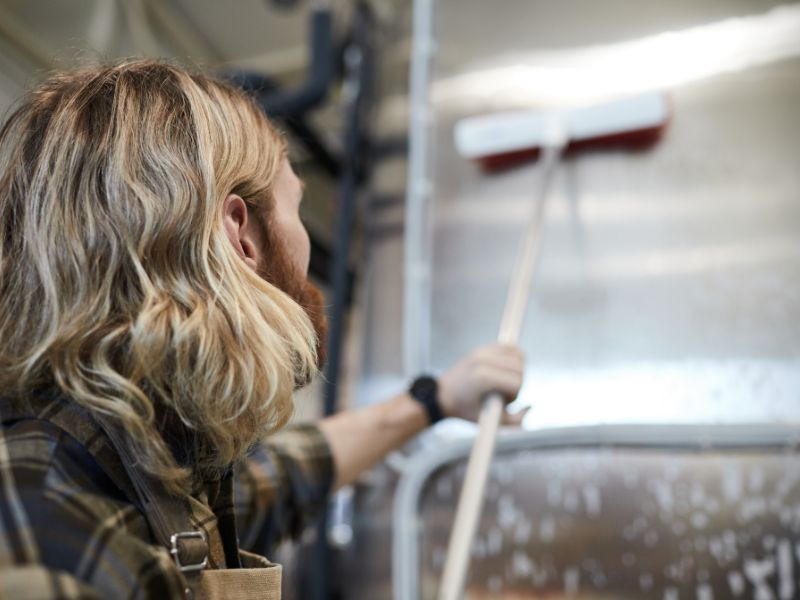7 key features to look for when shopping for a vertical form fill seal machine

Vertical form fill seal (VFFS) machines come in a variety of types but most follow a similar overall configuration. Differences become apparent in their construction materials, methods and components.
So how do you know what to look for to ensure you buy quality equipment? Here are 7 key features to pay attention to when shopping for a VFFS machine:
1. Machine frame construction
The packaging machine frame is what supports and stabilizes equipment, so it must be strong and robust if it's going to do its job right. Typically, the heavier the frame construction, the smoother the machine operates (we will get into why a smoothly operating machine is a good thing later on).
Machine frames made from stainless steel are ideal, providing unique advantages like a high strength-to-weight ratio, no chipping or flaking risk, and corrosion resistance.
Most frames are bolted together as standard. However, welded frames are a great option that reduces the risk of contaminant collection. Welded frames also do not need regular bolt tightening, since the bolts are welded to the frame and will not loosen over time.
2. Film tracking
Webs of flat packaging film have a tendency to shift off center as they are being drawn through the VFFS machine. Film can be tracked manually, but this is not ideal or cost-effective. It requires human intervention and is often not quick enough to adjust the film proactively. Thus, the operator will notice out of spec bags and will need to stop the machine, make manual adjustments, and perform rework. This increases downtime, contributes to product and film loss, and is overall entirely inefficient.
Most modern vertical packaging machines solve this by featuring automatic film tracking. This means that the machine will adapt in real time to keep the web of film centered and under consistent tension. This is accomplished using a sensor that detects the edge of the film and automatically shifts the entire film carriage to regain its center within the packaging machine.
3. Machine noise level
When it comes to packaging machines, the louder they are, the more wear and tear you can expect. While a bit of noise is normal and unavoidable, when you have to yell to communicate over a machine, this can signify future issues.
Remember, noise usually indicates friction and/or vibration of moving parts. And that usually leads to increased frequency of wear parts replacement, bolts and screws coming loose over time, increased risk of machine malfunction, and unplanned downtime.
The best way to assess vertical form fill seal machine noise levels is to ask a packaging machine manufacturer to see the machine running at their facility. If that's not possible, check out videos of the machine in production and turn up the sound.
4. Ease of changeover
Most VFFS machines can be changed over, or adjusted to accommodate a range of packaging bag sizes and types. This requires adjustments be made to the machine, both in its programming and physical configuration. Downtime from changeover is one of the top things automated packaging machine users complain about...it either takes too long or requires specialty tools.
On a modern VFFS machine, changeover should be easy and tool-free, and require about 30 – 45 minutes or less to complete. Rotary premade pouch machines can be changed over in a matter of minutes, usually less than 5.
5. Packaging machine controls
The controls system governs the starting, stopping, and function of the entire machine. Allen Bradley controls are the most popular and widely supported in the industry. Siemens controls are another popular option. Here's an explanation of a few controls components to pay attention to:
A vertical form fill seal machine needs a ‘brain’ to tell it what to do and when, and a 'monitor' through which to control the machine. Enter the Programmable Logic Controller (PLC) and Human Machine Interface (HMI). Like a hard drive, the PLC controls the packaging machine's functions and operation. The HMI, usually a 7 - 12" color touch screen, is the interface through which a human can make adjustments, observe feedback, and receive updates.
6. Sealing jaws
The sealing jaws on a VFFS machine are what bond the sealant layers of film together to create a strong package seam. As such, the jaws are an incredibly important component of a packaging system. They must operate reliably so each package receives the perfect seal, no matter if it’s package number 1 or 100,000.
Most popular are heat sealing jaws, which usually work in pairs and seal packages with a specific combination of heat, pressure, and dwell time.
The very best heat sealing jaws are forged from a single piece of material. This ensures even, consistent heat and pressure. When a jaw is comprised of multiple pieces, inconsistent heating and pressure can cause seams to be perfect on one side but incomplete on the opposite side, which leads to product loss and rework, both which cost you money in the long run.
7. Servo driven mechanisms
Servo drives offer the end user more precise control over machine components. With servo-driven components, a closed loop system provides continuous feedback regarding the position, velocity, and acceleration/deceleration of the component. This allows real-time data, adjustments, and precise repeatability.
A more simple pneumatic mechanism does not provide that level of insight, control, and accuracy.
Servo-driven mechanisms are generally considered a superior choice. Many modern machines now include servo drives as standard.
Considering a VFFS machine purchase?
Shopping for a VFFS machine doesn't need to be stressful. Download our free Guide to Vertical Form Fill Seal machines to learn even more about the ins and outs of this equipment type:





